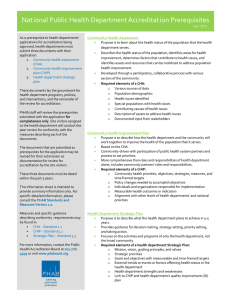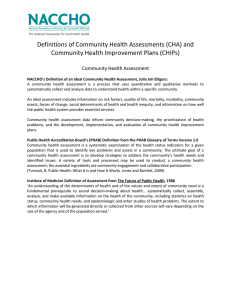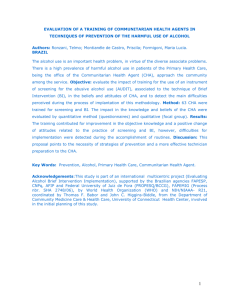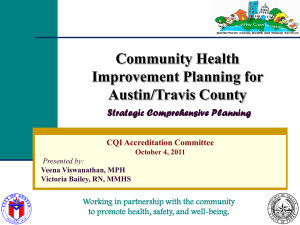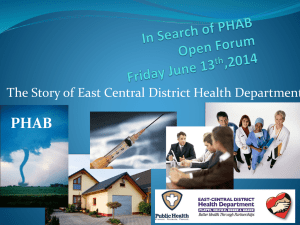Recommendations on Characteristics for High-Quality Community Health Assessments
advertisement
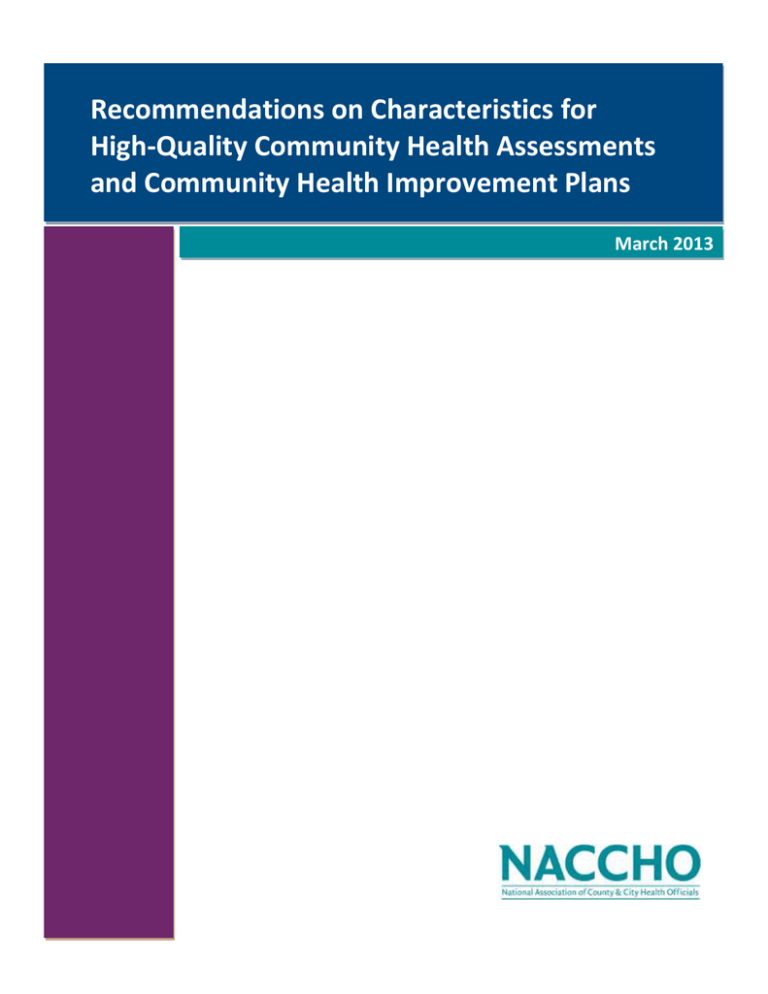
Recommendations on Characteristics for High-Quality Community Health Assessments and Community Health Improvement Plans March 2013 About the Recommendations These recommendations present the characteristics of a community health improvement process that yield a high-quality community health assessment (CHA) and community health improvement plan (CHIP), according to the National Association of County and City Health Officials (NACCHO). The characteristics were initially defined for 12 local health department (LHD) demonstration sites participating in NACCHO’s CHAs and CHIPs for Accreditation Preparation Demonstration Project. This project ended in December 2012 and resulted in the 12 LHDs and their partners completing comprehensive community health improvement processes that embodied these characteristics. The tools and example community health profiles presenting the CHA findings and CHIPs can all be accessed in NACCHO’s CHA/CHIP Resource Center. The recommendations are presented as a checklist to assist LHDs and others in tracking their efforts with particular attention to preparing for the Public Health Accreditation Board’s (PHAB’s) accreditation program. A full narrative description of the characteristics (i.e., not in checklist form) can be found in Appendix A. The recommendations outlined here are based on specific definitions of community health improvement processes, CHAs, and CHIPs detailed below; these definitions are similar to, although not exactly the same as, PHAB’s definitions. The characteristics were defined by a group of national public health organizations and content experts who served as partners and advisors on the project. Although developed by the group as recommendations for high quality, this document represents only the views of NACCHO and not necessarily the advisors or organizations participating in the project. A list of these advisors and partners can be found in Appendix B. Applying the Recommendations NACCHO intends for these recommended characteristics to be informative to those seeking to plan and conduct comprehensive community health improvement processes resulting in high-quality CHAs and CHIPs to measurably improve the public’s health, including LHDs seeking PHAB accreditation. Please note that the intention of these recommendations is not to suggest that community health improvement processes be uniform in conduct or be specific in format. Rather, this work should reflect the culture, size, experience, and expertise of the local community, while still striving to embody NACCHO’s recommended characteristics. Communities should interpret these characteristics on their own and tailor the process to their needs to ensure an end goal of measurable improvement in community health. Relationship to PHAB Standards and Measures These characteristics are meant, at minimum, to be inclusive of the CHA and CHIP-related PHAB Standards and Measures Version 1.0, excluding Standard and Measure 5.2.3 A and 5.2.4 A, which are focused on CHIP implementation. Embodiment of the characteristics outlined in these recommendations does not guarantee that the work will conform to PHAB’s Standards and Measures. Only PHAB site reviewers can make this determination. This checklist attempts to provide users with general guidance on the relationship between these characteristics and PHAB’s relevant Standards and Measures; the information here is not a replacement for a comprehensive review of the related PHAB Standards and Measures and Required Documentation Guidance, which must be considered the official resource for all PHAB procedures and requirements. Always consult the Standards and Measures before finalizing anything. 2 In several areas, the recommendations go beyond those that PHAB has outlined in its Standards and Measures Version 1.0. This was intentional and is meant to help LHDs and their partners “raise the bar” for high-quality CHAs and CHIPs as the foundation of their work. The three areas in which the project was more specific were (1) engaging community members and local public health system (LPHS) partners throughout the entire process; (2) addressing the social determinants of health; and (3) using quality improvement or quality planning techniques. LHDs that are seeking PHAB accreditation should refer directly to PHAB’s Standards and Measures Version 1.0. These recommendations are not a replacement for PHAB’s guidance. For more information about these recommendations, e-mail chachip@naccho.org. 3 Many definitions of and models for community health improvement processes, CHAs, and CHIPs exist. For the purposes of these recommendations, the following definitions of these terms apply: Community health improvement process: A comprehensive approach to assessing community health and developing and implementing action plans to improve community health through substantive community member1 and LPHS2 partner engagement. The community health improvement process yields two distinct yet connected deliverables: a community health assessment, the findings of which are presented in the form of a community health profile3 and a community health improvement plan. Community health assessment (CHA): A process that engages with community members and LPHS partners to systematically collect and analyze qualitative and quantitative health-related data from a variety of sources within a specific community. The findings of the CHA are presented in the form of a community health profile3 and inform community decision-making, the prioritization of health problems, and the development and implementation of community health improvement plans. Community health profile:3 A document or format that presents the findings of a community health assessment and that is widely distributed to LPHS, policymakers, and community members. Community health improvement plan (CHIP): An action-oriented plan outlining the priority community health issues (based on the community health assessment findings and community member and LPHS partner input) and how these issues will be addressed, including strategies and measures, to ultimately improve the health of a community. The CHIP is developed through the community health improvement process. The following recommended characteristics assume that all communities applying them will complete a community health profile presenting the findings of the CHA, a CHIP, and a compilation of information and documentation in the form of a report or otherwise to accompany and support either of the other two documents, especially for PHAB’s accreditation program. 1 The term “community member” refers to individuals living or working in the jurisdiction(s) upon which the community health improvement process focuses. The LPHS comprises entities including public, private, and voluntary organizations, agencies, groups, and individuals that have interests in population health, which may include but is not limited to academic institutions, business, civic groups, community-based organizations, community health centers, economic development, elected officials, employers, healthcare providers, health plans, hospitals, housing entities, LHDs, mental health care providers, parks, philanthropists, planning organizations, police, schools, transportation, and more. 3 Note that the definition of a community health profile used in these recommendations differs from the term “health data profile” used by PHAB in Standard 1.4.2 T/L. 2 4 Recommended CHA/CHIP Characteristics Checklist A Note about the Relationship to PHAB Standards and Measures These characteristics are meant, at minimum, to be inclusive of the CHA and CHIP-related PHAB Standards and Measures Version 1.0, excluding Standard and Measure 5.2.3 A and 5.2.4 A, which are focused on CHIP implementation. Embodiment of the characteristics outlined in these recommendations does not guarantee that the work will conform to PHAB’s Standards and Measures. Only PHAB site reviewers can make this determination. This checklist attempts to provide users with general guidance on the relationship between these characteristics and PHAB’s relevant Standards and Measures; the information here is not a replacement for a comprehensive review of the related PHAB Standards and Measures and Required Documentation Guidance, which must be considered the official resource for all PHAB procedures and requirements. Always consult the Standards and Measures before finalizing anything. For more information, please see pages 2–3 of these recommendations. Processes to Conduct the Community Health Improvement Process My community has met the following required characteristics in that our community health improvement process did the following: Related PHAB standard and measure (when applicable) 1. Used an assessment or improvement planning model. Measure 1.1.1 T/L 2. Engaged community members in a meaningful and substantive way throughout the CHA and CHIP processes. The community members involved reflected the diversity of the jurisdiction. Included broad representation from the local public health system (LPHS), including non-traditional partners. a. Partners were engaged in a strategic way throughout the CHA and CHIP processes. Measure 1.1.1 T/L 3. b. c. 4. Partners and stakeholders reflected the diversity of community members (e.g., CBOs working with a particular racial/ethnic group or with youth). Regular meetings were held with partners and stakeholders. Where in your deliverables is this found? (page #) Measure 1.1.1 T/L Measure 1.1.1 T/L Measure 1.1.1 T/L Measure 1.1.1 T/L Considered and addressed multiple determinants of health, especially social determinants, with a particular focus on the following: 5 a. 5. 6. Identified populations within their jurisdictions with an inequitable share of poor health outcomes. b. Assessed the social determinants of health in their jurisdiction and ensured that they were considered in indicator and data source selection, data collection, and data analysis. c. Included at least one of these issues as a priority for community health improvement efforts in addition to other health priorities in the CHIP. d. Relevant data and other resources such as the County Health Rankings project were used to help understand these conditions. e. Engaged non-traditional partners to address the root causes of health inequities in their communities. Used at least one quality improvement (QI) or quality planning technique in the community health improvement process and provided documentation of use. Leveraged local and state resources to conduct the CHA and develop the CHIP as demonstrated by support from the state health department, LPHS partners, or others in the state such as academic institutions and public health institutes. Measure 1.1.2 T/L Measure 1.1.2 T/L Measure 1.1.2 T/L Measure 1.1.2 T/L Community Health Profile Presenting the CHA Findings For PHAB, the related requirements can be found in PHAB Standard 1.1 for the CHA My Community has met the following required characteristics in that the community health profile does the following: Related PHAB standard and measure (when applicable) Where in your deliverables is this found? (page #) Background information 1. 2. 3. 4. 5. 6. Includes date completed and time period for which it is effective. Includes the health department’s full name in the cover and/or in the introduction of the document. Clearly describes the jurisdiction that was assessed. Measure 1.1.2 T/L Demonstrates that the CHA covered the LHD’s entire jurisdiction and not just one or more subsets of the LHD’s jurisdiction. It is acceptable for CHAs to cover a geographic area that extends beyond the LHD’s jurisdiction, but CHA must cover entire the LHD’s whole jurisdiction at minimum. Specifies the assessment or improvement model or the tailored approach used for the CHA. Measure 1.1.1 T/L Briefly describes how community members and LPHS partners were involved in the conduct of the CHA and had an opportunity to review and contribute to the CHA. Measure 1.1.1 T/L Measure 1.1.2 T/L Data and analyses 6 1. 2. Describes the characteristics of the overall population (age distribution, race and ethnicity, socioeconomic status, etc.). Demonstrates the use of a broad set of indicators of community health, well-being, and quality of life and multiple data sources. a. Considers a range of issues that affect health directly and indirectly. b. c. d. e. f. Incorporates data from a variety of sectors that influence health such as housing, education, transportation, etc. Includes data from both primary and secondary sources. Measure 1.1.2 T/L Measure 1.1.2 T/L Measure 1.1.2 T/L Measure 1.1.2 T/L Measure 1.1.2 T/L Identifies community members’ definition(s) of health and relationship to cultural needs and values. Identifies desired health and health-related outcomes from the perspective of community members. Uses federal, state, and/or local data as appropriate. g. 3. 4. 5. 6. 7. Uses qualitative data on community perceptions, assets, priorities, and the community health context. Demonstrates the use of indicators, data collection methods, and data analysis techniques that allowed for the identification and examination of health inequities. a. Contains data on indicators that represent a broad range of items that community members have indicated, or literature shows, may be inequitable. b. Uses data and data collection methods that can be analyzed and reviewed for health inequities. If a data source already exists for an indicator but the data cannot be analyzed for health inequities, considered using another data source or collecting new data on this indicator to fulfill this need. c. Conducts and presents findings of data analyses depicting the existence and extent of health inequities between and among sub-populations in the jurisdiction. Shows that both community assets/strengths, resources, and needs/gaps were assessed. Compares jurisdiction data with that of neighboring jurisdictions, the state, and/or the nation. Measure 1.1.2 T/L Measure 1.1.2 T/L Measure 1.1.2 T/L Includes a review of trends and sub-population specific data when possible (e.g., if sufficient data are available on health status, risk factors, etc. for different racial or ethnic groups, then the data presented should be stratified by race and ethnicity). Presents data in a manner that can be easily understood by broad group of stakeholders including community members and LPHS partners with little or no health background, which may include 7 use of graphs and charts. Summary of the major CHA findings 1. Describes the process used to synthesize all of the data to arrive at the major CHA findings. Measure 1.1.1 T/L 2. Presents the major CHA findings on assets and resources as well as areas for improvement. Measure 1.1.2 T/L Ensure that the Community Health Profile presenting the findings of the CHA and supporting documentation do the following: 1. Ensure that the community health profile presenting the findings of the CHA and supporting documentation are accessible to agencies, organizations, and the general public. Measure 1.1.3 T/L Community Health Improvement Plan For PHAB, the related requirements can be found in PHAB Standard 5.2 for the CHIP My community has met the following required characteristics in that the CHIP does the following: Related PHAB standard and measure (when applicable) Where in your deliverables is this found? (page #) Background information 1. 2. 3. 4. 5. 6. 7. Includes date completed and time period for which it is effective. Includes the health department’s full name in the cover and/or in the introduction of the document. Describes the assessment or improvement model or tailored approach used to conduct the community health improvement process Briefly describes the way in which community members and LPHS partners were engaged in development of the CHIP, particularly their involvement in both the issue prioritization and strategy development. Briefly describes how community members and LPHS partners identified issues and themes from which priorities were developed. References data and information from the CHA and how it informed the CHIP development process. Includes a general description of LPHS partners and community members who have agreed to support CHIP action. Reference partners’ participation in the short term and long term, as applicable. Measure 5.2.1 L Measure 5.2.1 L Measure 5.2.1 L Measure 5.2.1 L Priority issues section 1. Describes the process by which the priorities were identified. Measure 5.2.1 L & 5.2.2 L 8 2. Measure 5.2.2 L 5. Outlines the top priorities for action and includes a brief justification for why each issue is a priority. Shows alignment of community priorities with state, Tribal, and national health improvement priorities. Includes at least one priority aimed at addressing a social determinant of health that arose as a key determinant of a health inequity in the jurisdiction. Identifies community assets and resources. 6. Includes policy changes needed to accomplish health objectives. Measure 5.2.2 L 3. 4. Measure 5.2.1 L CHIP implementation plan 1. Clear, specific, realistic, and action-oriented goals. Measure 5.2.2 L 2. Measure 5.2.2 L 3. Goals and objectives for determined priorities in the short term (1–2 years) and intermediate term (2–4 years). Strategies for determined priorities. 4. Related performance measures and indicators of progress for each strategy. Measure 5.2.2 L 5. Realistic timelines for achieving goals and objectives. Measure 5.2.2 L 6. Designation of lead roles in CHIP implementation by goal, objective, or strategy for LPHS partners, including LHD role. Formal presentation of the role of relevant LPHS partners in implementing the plan and a demonstration of the organization’s commitment to these roles via letters of support or accountability. At least one evidence-based strategy and emphasis on evidence-based strategies, as possible. (Note: PHAB uses the terms “evidence-based or promising strategies” in the Standards and Measures Version 1.0). References to state-of-the-art guidance (e.g., National Prevention Strategy, Healthy People 2020, etc.). Measure 5.2.2 L 7. 8. 9. Measure 5.2.2 L Measure 5.2.2 L Measure 5.2.2 L Measure 5.2.2 L Community Health Improvement Process Report This section was developed for demonstration sites only; however, much of what is listed here will help ensure a health department has the documentation needed for the CHA and CHIP for the purposes of PHAB’s accreditation program. For PHAB, the related requirements can be found in PHAB Standards 1.1 and 5.2 for the CHA and CHIP 9 My community has met the following required characteristics in that the Community Health Improvement Process Report does the following: Related PHAB standard and measure (when applicable) 1. Clearly describes the jurisdiction(s) that was assessed and includes a brief description of how this was determined. Measure 1.1.2 T/L 2. Describes why the assessment or improvement model or tailored approach used to conduct the community health improvement process was chosen. Measure 1.1.1 T/L & 5.2.1 L Where in your deliverables is this found? (page #) CHA and Community Health Profile overview 1. 2. 3. 4. 5. 6. 7. 8. 9. Briefly describes the CHA process, including the indicators, data collection methods, and data analysis techniques that were used in the CHA and how and why they were selected. Describes and provides documentation for how community members and LPHS partners were involved in conducting the CHA. Describes and provides documentation for how community member and LPHS partner input was gathered in the CHA. Describes and provides documentation for how regular meetings with LPHS partners and stakeholders were held. Describes how the site examined the social and economic determinants of health in conducting the CHA. Discusses the qualitative data used in the CHA and how they were obtained. Discusses the type of data analyses used to do the following: a. Ensure that analyses were meaningful and appropriate for jurisdiction/community size and characteristics. b. Analyze data such that it provided information on trends and sub-population-specific data that were presented in the community health profile. c. Ensure that health inequities in sub-populations were identified to the maximal degree allowed by the data. Discusses how community assets/strengths were assessed. Summarizes the major CHA findings and describes the process by which these were identified. a. Presents a description of the process used to synthesize all of the data to arrive at the major CHA findings. b. Specifies who was involved in synthesizing the data and identifying major findings. 10. Discusses how the community health profile presenting the findings of the CHA was created and Measure 1.1.2 T/L Measure 1.1.1 T/L & 1.1.2 T/L Measure 1.1.1 T/L & 1.1.2 T/L Measure 1.1.1 T/L Measure 1.1.2 T/L Measure 1.1.2 T/L Measure 1.1.1 T/L Measure 1.1.2 T/L & 10 how it was/will be distributed to the public. 1.1.3 A CHIP overview 1. 2. 3. 4. Describes how community members and LPHS partners were engaged in development of the CHIP, especially for issue prioritization and strategy development. Summarizes the top priorities for action and the process by which they were identified. 6. 7. 8. Measure 5.2.1 L & 5.2.2 L Specifies how the strategy aimed at addressing a social or economic determinant of health or a heath inequity was identified. Describes how the CHIP implementation plan was developed. a. Includes who was involved in the process. b. 5. Measure 5.2.1 L Describes the respective roles of all involved in the development process. Specifies which strategies are evidence-based, what the source of the evidence is, and how these strategies were identified and selected. (Note: PHAB uses the terms “evidence-based or promising strategies” in the Standards and Measures Version 1.0) Describes how the CHIP and CHIP implementation plan was/will be distributed to the public. Measure 5.2.2 L Describes the plan for monitoring CHIP implementation progress and sustaining action beyond initial CHIP rollout, including reporting on progress to the public. Describes how the QI or quality planning technique used in the community health improvement process was chosen and who was involved in applying the technique. Measure 5.2.4 A 11 Appendix A: Narrative description of the recommended characteristics for highquality CHAs and CHIPs A Note about the Relationship to PHAB Standards and Measures These characteristics are meant, at minimum, to be inclusive of the CHA and CHIP-related PHAB Standards and Measures Version 1.0, excluding Standard and Measure 5.2.3 A and 5.2.4 A, which are focused on CHIP implementation. Embodiment of the characteristics outlined in these recommendations does not guarantee that the work will conform to PHAB’s Standards and Measures. Only PHAB site reviewers can make this determination. This checklist attempts to provide users with general guidance on the relationship between these characteristics and PHAB’s relevant Standards and Measures; the information here is not a replacement for a comprehensive review of the related PHAB Standards and Measures and Required Documentation Guidance, which must be considered the official resource for all PHAB procedures and requirements. Always consult the Standards and Measures before finalizing anything. For more information on the background and potential application of these characteristics, please see pages 2–3 of these recommendations. Required Characteristics of Processes to Conduct the Community Health Improvement Process 1. Use an assessment or improvement planning model, such as Mobilizing for Action through Planning and Partnerships, state-specific models, or an individually tailored approach that combines elements of models to best fit the context and history of the jurisdiction. 2. Engage with community members. a. Community member refers to those individuals living or working in the jurisdiction(s) on which the project focuses. b. Community members must be engaged in a meaningful and substantive way throughout the CHA and CHIP processes, including indicator selection, data collection, data analysis, data presentation and distribution, issue prioritization, CHIP creation, implementation of CHIP, and monitoring of results. c. Involvement of community members must reflect the diversity of the jurisdiction. 3. Include broad representation from the LPHS. a. The LPHS comprises entities including public, private and voluntary organizations, agencies, groups, and individuals that have interests in population health or are reflective of issues associated with the multiple determinants of health (i.e., economic, social, and physical environmental conditions affecting health). Specific examples of these entities include academic institutions, business, civic groups, community-based organizations (CBOs), community health centers, economic development, elected officials, employers, healthcare providers, health plans, hospitals, housing entities, mental health care providers, parks, philanthropists, planning organizations, police, schools, transportation, and more. b. Partners should be engaged in a strategic way throughout the CHA and CHIP processes, including gaining access to data, mobilizing community members, data collection, data review, issue prioritization, and CHIP implementation. c. Partners and stakeholders should reflect the diversity of community members (e.g., CBOs working with a particular racial/ethnic group or with youth). d. Sites are encouraged to engage with LPHS partners with whom they have previously collaborated and those with whom they have not; it is expected that sites will form or strengthen new partnerships, particularly with non-traditional partners. 12 4. Address the social determinants of health. a. Sites will need to consider multiple determinants of health, especially social determinants like social and economic conditions that are often the root causes of poor health and health inequities among sub-populations in their jurisdictions. Examples of social and economic conditions that influence health include housing, job availability, neighborhood safety, and access to high-quality education. b. The project seeks to ensure that the CHAs conducted and the CHIPs developed have a particular focus on the following: a) Identifying populations within their jurisdictions with an inequitable share of poor health outcomes; b) Assessing the social determinants of health in their jurisdiction and ensuring that they are considered in indicator and data source selection, data collection, and data analysis; and c) Including at least one of these issues as a priority for community health improvement efforts in addition to other health priorities in the CHIP. c. Relevant data and other resources from the County Health Rankings project will be used to help understand these conditions. d. Sites must engage non-traditional partners (i.e., those not historically involved in community health improvement processes) to address the root causes of health inequities in their communities. 5. Use QI or quality planning techniques. a. Sites with previous CHA and CHIP experience will apply QI techniques to improve their efforts in a systematic and data-driven way for the purposes of the project and/or improve their planning through use of quality planning techniques. b. Sites with no previous CHA and CHIP experience will use quality planning techniques throughout their project. 6. Leverage local and state resources to conduct the CHA and develop the CHIP. Sites are expected to fully consider the breadth of resources, skills, and other capacities available in their community to undertake their community health improvement process. Sites should actively consider increasing their capacity by seeking additional support from the state health department, LPHS partners, or others in the state such as academic institutions and public health institutes (in-person or virtually) to expand the capacity of the LHD and its partners to increase awareness of the health issues and complete the project deliverables. This support might include provision of data sources, connections to non-traditional partners, personnel, and convening functions. Required Characteristics of the Community Health Profile The following characteristics are required of the community health profile. This description is not comprehensive but is intended to give sites a sense of the attributes needed to meet the grant and PHAB requirements. Additional guidance and materials were provided to the selected sites. A. Background information that does the following: a. Clearly describes the jurisdiction that was assessed. It is acceptable for CHAs to cover a geographic area that extends beyond the LHD’s jurisdiction, but it may not focus on only a subset of the LHD’s jurisdiction. b. Specifies the assessment or improvement model or the tailored approach used for the CHA. c. Briefly describes how community members and LPHS partners were involved in the CHA. B. Data and analyses that do the following: a. Describe the characteristics of the overall population (age distribution, race and ethnicity, socioeconomic status, etc.). 13 b. c. d. e. f. C. Demonstrate the use of a broad set of indicators of community health, well-being, and quality of life and multiple data sources. i. Consider a range of issues that affect health directly and indirectly. ii. Incorporate data from a variety of sectors that influence health such as housing, education, transportation, etc. iii. Identify community members’ definition(s) of health and relationship to cultural needs and values. iv. Identify desired health and health-related outcomes from the perspective of community members. v. Use federal, state, and/or local data as appropriate. vi. Use qualitative data as well as quantitative data. Include qualitative data on community perceptions, assets, priorities, and the community health context. Demonstrate the use of indicators, data collection methods, and data analysis techniques that allow for the identification and examination of health inequities. i. Choose indicators that represent a broad range of items that community members have indicated or that literature shows may be inequitable. ii. Use data and data collection methods that can be analyzed and reviewed for health inequities (i.e., if a data source already exists for an indicator but the data cannot be analyzed for health inequities, consider using another data source or collecting new data on this indicator to fulfill this need). iii. Ensure that sample sizes are large enough, when appropriate, to allow for data analysis to examine health inequities between and among sub-populations. Show that community assets/strengths, resources, and needs/gaps were assessed. Compare jurisdiction data with that of neighboring jurisdictions, the state, and/or the nation. Include a review of trends and sub-population specific data when possible (e.g., if sufficient data are available on health status, risk factors, etc. for different racial or ethnic groups, then the data presented should be stratified by race and ethnicity). A summary of the major CHA findings that does the following: a. Describes the process used to synthesize all of the data to arrive at the major CHA findings. b. Presents the major CHA findings. Required Characteristics of the CHIP The following characteristics are required of the CHIP. This description is not comprehensive but is intended to give sites a sense of the attributes needed to meet the grant and PHAB requirements. Additional guidance and materials was provided to the selected sites. A. Background information that does the following: a. Describes the jurisdiction for which the CHIP pertains and a brief description of how this was determined. b. Briefly describes the way in which community members and LPHS partners were engaged in development of the CHIP, particularly their involvement in both the issue prioritization and strategy development. c. Includes a general description of LPHS partners and community members who have agreed to support CHIP action. Reference partners’ participation in the short term and long term as applicable. B. Priority issues section that does the following: a. Describes the process by which the priorities were identified. b. Outlines the top priorities for action. The priorities need to include at least one priority aimed at addressing a social determinant of health that arose as a key determinant of a health inequity in the jurisdiction. c. Includes a brief justification for why each issue is a priority. 14 C. A CHIP implementation plan that does the following: a. Provides clear, specific, realistic, and action-oriented goals. b. Contains the following: i. Goals, objectives, strategies, and related performance measures for determined priorities in the short term (1–2 years) and intermediate term (2–4 years). ii. Realistic timelines for achieving goals and objectives. iii. Designation of lead roles in CHIP implementation for LPHS partners, including LHD role. iv. Formal presentation of the role of relevant LPHS partners in implementing the plan and a demonstration of the organization’s commitment to these roles via letters of support or accountability. v. Emphasis on evidence-based strategies. vi. A general plan for sustaining action. Requirements of the Community Health Improvement Process Report, for Demonstration Site Participants This description is not comprehensive but is intended to give sites a sense of the attributes needed to meet the grant and PHAB requirements. Additional guidance and materials for the report was provided to selected sites. 1. 2. 3. 4. 5. Clearly describe the jurisdiction(s) that was assessed and include a brief description of how this was determined. Describe the assessment or improvement model or tailored approach used in the conduct of the community health improvement process and briefly describe why this model was chosen. CHA and Community Health Profile overview: a. Briefly describe the CHA process including the indicators, data collection methods, and data analysis techniques that were used in the CHA and how and why they were selected. b. Describe and provide documentation for how community members and LPHS partners were involved in conducting the CHA. c. Describe and provide documentation for how community member and LPHS partner input was gathered in the CHA. d. Describe how the site addressed the social and economic determinants of health in conducting the CHA. e. Discuss the qualitative data used in the CHA and how they were obtained. f. Discuss the type of data analyses conducted to do the following: i. Ensure that analyses were meaningful and appropriate for jurisdiction/community size and characteristics. When possible and appropriate, data analysis should allow for review of trends and sub-population-specific data and these data should be presented in the CHA report; and ii. Ensure that health inequities in sub-populations were identified to the maximal degree allowed by the data. g. Discuss how community assets/strengths were assessed. h. Summarize the major CHA findings and describe the process by which these were identified. i. Present a description of the process used to synthesize all of the data to arrive at the major CHA findings. ii. Specify who was involved in synthesizing the data and identifying major findings. Discuss how the community health profile was created and how it was/will be distributed to the public. CHIP overview: a. Describe how community members and LPHS partners were engaged in development of the CHIP, especially for issue prioritization and strategy development. b. Summarize the top priorities for action and the process by which they were identified. c. Specify how the strategy aimed at addressing a social or economic determinant of health/heath inequity was identified. d. Describe how the CHIP implementation plan was developed. i. Include who was involved in the process. ii. Describe the respective roles of all involved in the development process. 15 e. f. g. Specify which strategies are evidence-based and how they were identified. Describe how the CHIP and implementation plan was/will be distributed to the public. Describe the plan for monitoring CHIP implementation progress and sustaining action beyond initial CHIP rollout, including reporting on progress to the public. 16 Appendix B: CHAs and CHIPs for Accreditation Preparation Demonstration Project Advisors and Partners Robert Wood Johnson Foundation was the Funding Partner. NACCHO’s development and implementation of the demonstration project and these recommended characteristics for high-quality CHAs and CHIPs were informed by the following project advisors and partners. Although developed by the group as recommendations for high quality, this document represents only the views of NACCHO and not necessarily the advisors or organizations participating in the project. Kaye Bender, Public Health Accreditation Board Michael Bilton, Association for Community Health Improvement*(see note below) Liza Corso, Centers for Disease Control and Prevention's Office for State, Tribal, Local, and Territorial Support Paul Campbell Erwin, Independent Consultant Patrick Libbey, Independent Consultant Allen Lomax, Community Indicators Consortium Marni Mason, MarMason Consulting, LLC Lisa McCracken, Holleran Consulting Jennifer McKeever, National Network of Public Health Institutes Jim Pearsol, Association of State and Territorial Health Officials Pamela Russo, Robert Wood Johnson Foundation Lee Thielen, Public Health Consultant Katie Wehr, Robert Wood Johnson Foundation Julie Willems Van Dijk, University of Wisconsin Population Health Institute *Mr. Bilton worked at the Association for Community Health Improvement at the time the document was developed; in early 2013, Mr. Bilton changed employment and at the time of document publication is working for Verité Healthcare Consulting. 17
